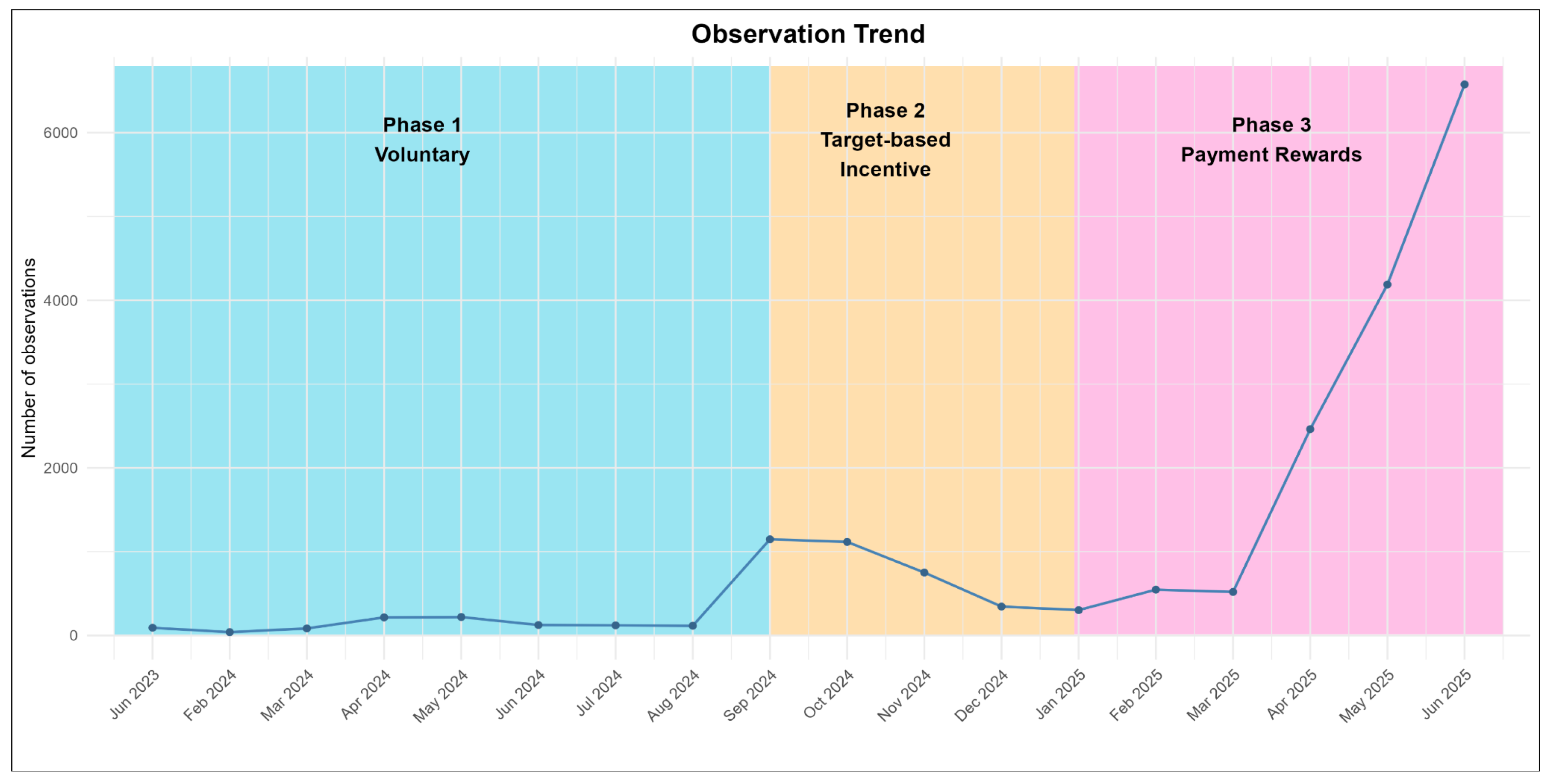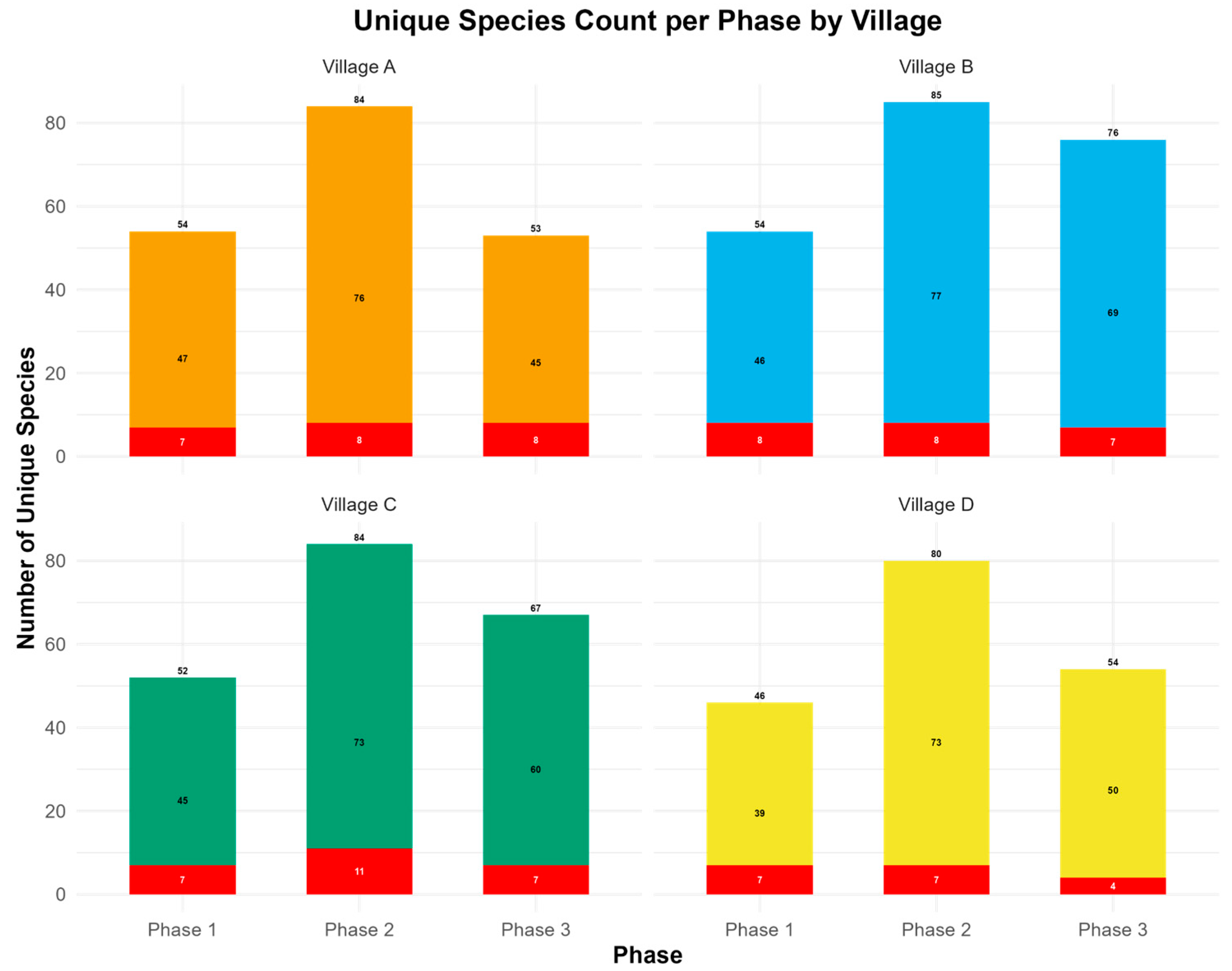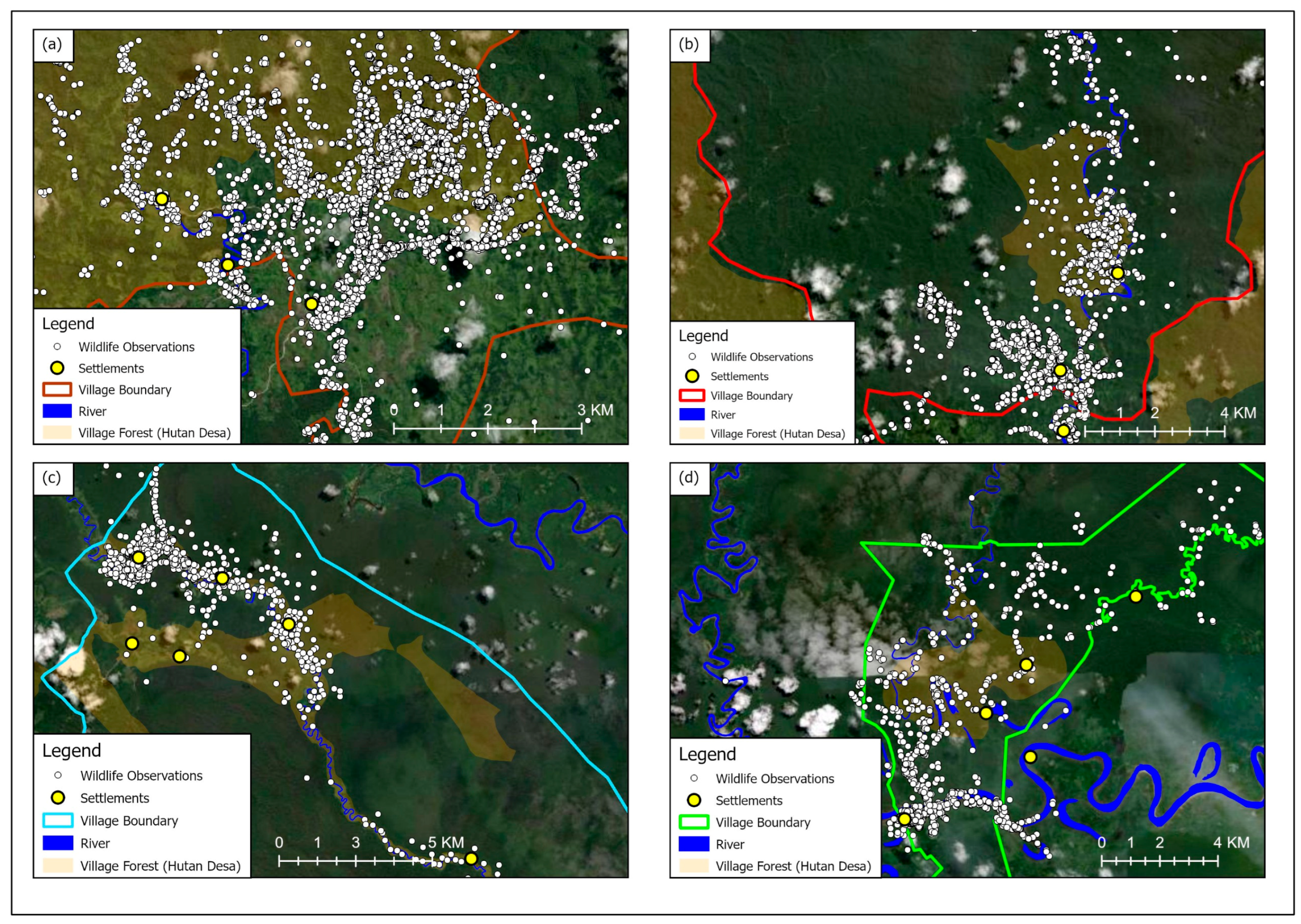Centering Communities in Biodiversity Monitoring and Conservation: Preliminary Insights from a Citizen Science Initiative in Kalimantan, Indonesia
Abstract
1. Introduction
- Evaluate the quality and reliability of data generated through CS initiatives in select rural communities in Indonesian Borneo, with an emphasis on identifying the variables that influence data accuracy and exploring methods to enhance data integrity within these contexts;
- Examine the motivations for participation, levels of engagement, and demographic diversity of CS participants in these communities, with a particular focus on the roles of different demographic groups, including women, youth, and elders, and the integration of traditional knowledge into the data collection process;
- Analyze the long-term impacts of CS involvement on both the participants and the scientific outcomes, including how participation influences local attitudes toward environmental conservation and the propensity for continued engagement in scientific and conservation activities;
- Develop evidence-based recommendations for the design and implementation of CS projects in rural communities, ensuring that initiatives are culturally sensitive, sustainable, and capable of producing high-quality scientific data while promoting local community engagement and empowerment.
2. Materials and Methods
2.1. Study Area
2.2. Local Engagement and Contextual Knowledge
2.3. Wildlife Data Collection and Verification
2.4. Ethical Considerations
2.5. Data Collection Methods
2.5.1. Phase 1: Voluntary Data Collection (May 2023–August 2024)
2.5.2. Phase 2: Incentive-Based Tablet Mapping (September–December 2024)
2.5.3. Phase 3: Payment for Observations (January 2025–Ongoing)
3. Results
3.1. Participant Engagement and Data Quality
3.1.1. Participant Engagement
3.1.2. PLEO Interviews
3.1.3. Observation Data
3.1.4. Data Quality
3.2. Motivation
3.2.1. Observation Trends and Cost Comparison
3.2.2. Trust and Credibility
3.2.3. Technology Adaptation
3.3. Data Biases
4. Discussion
4.1. Lessons Learned
4.2. Challenges and Limitations
4.3. Future Directions
5. Conclusions
Supplementary Materials
Author Contributions
Funding
Institutional Review Board Statement
Informed Consent Statement
Data Availability Statement
Acknowledgments
Conflicts of Interest
Abbreviations
| CS | Citizen Science |
| FPIC | First, Prior, and Informed Consent |
References
- Gooding, L.; Pateman, R.M.; West, S.E. Citizen Science and Its Potential for Aiding Low Carbon Energy Transitions. Energy Res. Soc. Sci. 2024, 117, 103702. [Google Scholar] [CrossRef]
- Katapally, T.R. A Global Digital Citizen Science Policy to Tackle Pandemics Like COVID-19. J. Med. Internet Res. 2020, 22, e19357. [Google Scholar] [CrossRef]
- Jansen, M.; Beukes, M.; Weiland, C.; Blumer, M.; Rudolfi, M.; Poerting, J.; Meißner, R.; Weiß, M.; Condori, Y.; Aramayo-Ledezma, G.; et al. Engaging Citizen Scientists in Biodiversity Monitoring: Insights from the WildLIVE! Project. Citiz. Sci. Theory Pract. 2024, 9, 6. [Google Scholar] [CrossRef]
- Albagli, S.; Iwama, A.Y. Citizen Science and the Right to Research: Building Local Knowledge of Climate Change Impacts. Humanit. Soc. Sci. Commun. 2022, 9, 39. [Google Scholar] [CrossRef]
- Albert, A.; Balázs, B.; Butkevičienė, E.; Mayer, K.; Perelló, J. Citizen Social Science: New and Established Approaches to Participation in Social Research. In The Science of Citizen Science; Vohland, K., Land-Zandstra, A., Ceccaroni, L., Lemmens, R., Perelló, J., Ponti, M., Samson, R., Wagenknecht, K., Eds.; Springer International Publishing: Cham, Switzerland, 2021; pp. 119–138. ISBN 978-3-030-58277-7. [Google Scholar]
- MacKinnon, K.; Hatta, G.; Halim, H.; Mangalik, A. The Ecology of Kalimantan: Indonesian Borneo; Tuttle Publishing: New York, NY, USA, 2013; ISBN 978-1-4629-0505-8. [Google Scholar]
- Myers, N.; Mittermeier, R.A.; Mittermeier, C.G.; Da Fonseca, G.A.B.; Kent, J. Biodiversity Hotspots for Conservation Priorities. Nature 2000, 403, 853–858. [Google Scholar] [CrossRef]
- Benyei, P.; Skarlatidou, A.; Argyriou, D.; Hall, R.; Theilade, I.; Turreira-García, N.; Latreche, D.; Albert, A.; Berger, D.; Cartró-Sabaté, M.; et al. Challenges, Strategies, and Impacts of Doing Citizen Science with Marginalised and Indigenous Communities: Reflections from Project Coordinators. Citiz. Sci. Theory Pract. 2023, 8, 21. [Google Scholar] [CrossRef]
- Van Strien, A.J.; Van Swaay, C.A.M.; Termaat, T. Opportunistic Citizen Science Data of Animal Species Produce Reliable Estimates of Distribution Trends If Analysed with Occupancy Models. J. Appl. Ecol. 2013, 50, 1450–1458. [Google Scholar] [CrossRef]
- Moeliono, M.; Mulyana, A.; Adnan, H.; Manalu, P.; Yuliani, L. Balang Village Forests (Hutan Desa): Empowerment, Business or Burden? Agroforestry and Forestry in Sulawesi No. 51; World Agroforestry Centre—ICRAF Southeast Asia Regional Office: Bogor, Indonesia, 2015. [Google Scholar]
- Colfer, C.J.P.; White, R.L.; Howard, E.; Prabhu, R. Inter-Generational Access to Resources: Developing Criteria and Indicators; Center for International Forestry Research (CIFOR): Bogor, Indonesia, 1997. [Google Scholar] [CrossRef]
- Dudley, R.G. The Fishery of Danau Sentarum. Borneo Res. Bull. 2000, 31, 261–306. [Google Scholar]
- Van Der Hoeven, C.A.; De Boer, W.F.; Prins, H.H.T. Pooling Local Expert Opinions for Estimating Mammal Densities in Tropical Rainforests. J. Nat. Conserv. 2004, 12, 193–204. [Google Scholar] [CrossRef]
- Esri. Survey123 for ArcGIS, Version 3.23.36. Mobile Application Software. Environmental Systems Research Institute: Redlands, CA, USA, 2024. Available online: https://survey123.arcgis.com (accessed on 29 July 2025).
- Wadley, R.L.; Colfer, C.J.P. Sacred Forest, Hunting, and Conservation in West Kalimantan, Indonesia. Hum. Ecol. 2004, 32, 313–338. [Google Scholar] [CrossRef]
- Yuliani, E.L.; Bakara, D.O.; Ilyas, M.; Russon, A.E.; Salim, A.; Sammy, J.; Sunderland-Groves, J.L.; Sunderland, T.C.H. Bornean Orangutan Pongo pygmaeus pygmaeus Population Estimate within and around Danau Sentarum National Park, Kapuas Hulu, West Kalimantan. Conserv. Sci. Pract. 2023, 5, e12916. [Google Scholar] [CrossRef]
- Franco, A.M.A.; Palmeirim, J.M.; Sutherland, W.J. A Method for Comparing Effectiveness of Research Techniques in Conservation and Applied Ecology. Biol. Conserv. 2007, 134, 96–105. [Google Scholar] [CrossRef]
- Haysom, J.K.; Deere, N.J.; Wearn, O.R.; Mahyudin, A.; Jami, J.B.; Reynolds, G.; Struebig, M.J. Life in the Canopy: Using Camera-Traps to Inventory Arboreal Rainforest Mammals in Borneo. Front. For. Glob. Change 2021, 4, 673071. [Google Scholar] [CrossRef]
- Maharani, N.; Nardiyono; Munthe, C.R.; Swayanuar, P.; Ni’Matullah, S.; Sueif, S.; Zaini, S.; Supriatna, J.; Kusrini, M.; Dennis, R.; et al. A Novel Citizen Science-Based Wildlife Monitoring and Management Tool for Oil Palm Plantations. Preprint 2025, 2025011201. [Google Scholar] [CrossRef]
- Van Strien, A.J.; Meijaard, E.; Nardiyono; Suief, S.; Zaini, S. Occupancy Estimation of Wild Species in a Palm Oil Plantation Using Unstructured Data. Preprint 2025. [Google Scholar] [CrossRef]
- Ferraro, P.J.; Simorangkir, R. Conditional Cash Transfers to Alleviate Poverty Also Reduced Deforestation in Indonesia. Sci. Adv. 2020, 6, eaaz1298. [Google Scholar] [CrossRef] [PubMed]
- Fletcher, R.; Büscher, B. Conservation Basic Income: A Non-Market Mechanism to Support Convivial Conservation. Biol. Conserv. 2020, 244, 108520. [Google Scholar] [CrossRef]
- Jayachandran, S.; de Laat, J.; Lambin, E.F.; Stanton, C.Y.; Audy, R.; Thomas, N.E. Cash for Carbon: A Randomized Trial of Payments for Ecosystem Services to Reduce Deforestation. Science 2017, 357, 267–273. [Google Scholar] [CrossRef] [PubMed]
- Milne, S.; Niesten, E. Direct Payments for Biodiversity Conservation in Developing Countries: Practical Insights for Design and Implementation. Oryx 2009, 43, 530–541. [Google Scholar] [CrossRef]
- Sheehan, C.; Martin-Ortega, J. Is Conservation Basic Income a Good Idea? A Scoping Study of the Views of Conservation Professionals on Cash Giving Programmes. Biol. Conserv. 2023, 279, 109914. [Google Scholar] [CrossRef]
- Wilebore, B.; Voors, M.; Bulte, E.H.; Coomes, D.; Kontoleon, A. Unconditional Transfers and Tropical Forest Conservation: Evidence from a Randomized Control Trial in Sierra Leone. Am. J. Agric. Econ. 2019, 101, 894–918. [Google Scholar] [CrossRef]
- WWF (WWF International). Main Report: Assessing the Application of a Conservation Performance Payment (CPP) for Communities in the Greater Virunga Landscape (GVL); WWF: Gland, Switzerland, 2024; 66p. [Google Scholar]
- Deci, E.L. Effects of Externally Mediated Rewards on Intrinsic Motivation. J. Pers. Soc. Psychol. 1971, 18, 105–115. [Google Scholar] [CrossRef]
- Deci, E.L.; Koestner, R.; Ryan, R.M. A Meta-Analytic Review of Experiments Examining the Effects of Extrinsic Rewards on Intrinsic Motivation. Psychol. Bull. 1999, 125, 627–668. [Google Scholar] [CrossRef]
- Dickinson, J.L.; Zuckerberg, B.; Bonter, D.N. Citizen Science as an Ecological Research Tool: Challenges and Benefits. Annu. Rev. Ecol. Evol. Syst. 2010, 41, 149–172. [Google Scholar] [CrossRef]





| Villages | Year | ||
|---|---|---|---|
| 2000 | 2019 | 2024 | |
| A | 419.1 (2.0) | 164.2 (2.5) | 61.8 (4.0) |
| B | 1322.4 (1.3) | 774 (1.2) | 750 (1.0) |
| C | 273.7 (1.7) | 89.6 (1.9) | 30.2 (1.8) |
| D | 119.8 (2.2) | 39.1 (1.8) | 25.9 (1.6) |
| Total | 2135.0 | 1066.9 | 867.9 |
| Village | Average Monthly Payment (USD) |
|---|---|
| A | 986 |
| B | 613 |
| C | 61 |
| D | 162 |
Disclaimer/Publisher’s Note: The statements, opinions and data contained in all publications are solely those of the individual author(s) and contributor(s) and not of MDPI and/or the editor(s). MDPI and/or the editor(s) disclaim responsibility for any injury to people or property resulting from any ideas, methods, instructions or products referred to in the content. |
© 2025 by the authors. Licensee MDPI, Basel, Switzerland. This article is an open access article distributed under the terms and conditions of the Creative Commons Attribution (CC BY) license (https://creativecommons.org/licenses/by/4.0/).
Share and Cite
Omar, M.S.; Dennis, R.; Meijaard, E.M.; Sueif, S.; Zaini, S.; Mohamdih, M.; Erman, A.; Meijaard, E. Centering Communities in Biodiversity Monitoring and Conservation: Preliminary Insights from a Citizen Science Initiative in Kalimantan, Indonesia. Diversity 2025, 17, 679. https://doi.org/10.3390/d17100679
Omar MS, Dennis R, Meijaard EM, Sueif S, Zaini S, Mohamdih M, Erman A, Meijaard E. Centering Communities in Biodiversity Monitoring and Conservation: Preliminary Insights from a Citizen Science Initiative in Kalimantan, Indonesia. Diversity. 2025; 17(10):679. https://doi.org/10.3390/d17100679
Chicago/Turabian StyleOmar, Muhammad Syazwan, Rona Dennis, Emily Mae Meijaard, Syafiie Sueif, Syahmi Zaini, Muiz Mohamdih, Andi Erman, and Erik Meijaard. 2025. "Centering Communities in Biodiversity Monitoring and Conservation: Preliminary Insights from a Citizen Science Initiative in Kalimantan, Indonesia" Diversity 17, no. 10: 679. https://doi.org/10.3390/d17100679
APA StyleOmar, M. S., Dennis, R., Meijaard, E. M., Sueif, S., Zaini, S., Mohamdih, M., Erman, A., & Meijaard, E. (2025). Centering Communities in Biodiversity Monitoring and Conservation: Preliminary Insights from a Citizen Science Initiative in Kalimantan, Indonesia. Diversity, 17(10), 679. https://doi.org/10.3390/d17100679






